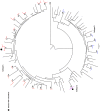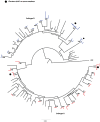HIV-1 transmission networks in high risk fishing communities on the shores of Lake Victoria in Uganda: A phylogenetic and epidemiological approach
- PMID: 29023474
- PMCID: PMC5638258
- DOI: 10.1371/journal.pone.0185818
HIV-1 transmission networks in high risk fishing communities on the shores of Lake Victoria in Uganda: A phylogenetic and epidemiological approach
Abstract
Background: Fishing communities around Lake Victoria in sub-Saharan Africa have been characterised as a population at high risk of HIV-infection.
Methods: Using data from a cohort of HIV-positive individuals aged 13-49 years, enrolled from 5 fishing communities on Lake Victoria between 2009-2011, we sought to identify factors contributing to the epidemic and to understand the underlying structure of HIV transmission networks. Clinical and socio-demographic data were combined with HIV-1 phylogenetic analyses. HIV-1 gag-p24 and env-gp-41 sub-genomic fragments were amplified and sequenced from 283 HIV-1-infected participants. Phylogenetic clusters with ≥2 highly related sequences were defined as transmission clusters. Logistic regression models were used to determine factors associated with clustering.
Results: Altogether, 24% (n = 67/283) of HIV positive individuals with sequences fell within 34 phylogenetically distinct clusters in at least one gene region (either gag or env). Of these, 83% occurred either within households or within community; 8/34 (24%) occurred within household partnerships, and 20/34 (59%) within community. 7/12 couples (58%) within households clustered together. Individuals in clusters with potential recent transmission (11/34) were more likely to be younger 71% (15/21) versus 46% (21/46) in un-clustered individuals and had recently become resident in the community 67% (14/21) vs 48% (22/46). Four of 11 (36%) potential transmission clusters included incident-incident transmissions. Independently, clustering was less likely in HIV subtype D (adjusted Odds Ratio, aOR = 0.51 [95% CI 0.26-1.00]) than A and more likely in those living with an HIV-infected individual in the household (aOR = 6.30 [95% CI 3.40-11.68]).
Conclusions: A large proportion of HIV sexual transmissions occur within house-holds and within communities even in this key mobile population. The findings suggest localized HIV transmissions and hence a potential benefit for the test and treat approach even at a community level, coupled with intensified HIV counselling to identify early infections.
Conflict of interest statement
Figures






References
-
- Cambiano V, O'Connor J, Phillips AN, Rodger A, Lodwick R, Pharris A, et al. Antiretroviral therapy for prevention of HIV transmission: implications for Europe. Euro surveillance: bulletin Europeen sur les maladies transmissibles = European communicable disease bulletin. 2013;18(48):20647 Epub 2013/12/07. - PubMed
-
- UNAIDS (2014). The GAP Report 2014
-
- Kissling E, Allison EH, Seeley JA, Russell S, Bachmann M, Musgrave SD, et al. Fisherfolk are among groups most at risk of HIV: cross-country analysis of prevalence and numbers infected. AIDS. 2005;19(17):1939–46. Epub 2005/11/02. - PubMed
-
- Smolak A. A meta-analysis and systematic review of HIV risk behavior among fishermen. AIDS care. 2014;26(3):282–91. Epub 2013/08/15. doi: 10.1080/09540121.2013.824541 - DOI - PubMed
-
- Kamali A, Nsubuga RN, Ruzagira E, Bahemuka U, Asiki G, Price MA, et al. Heterogeneity of HIV incidence: a comparative analysis between fishing communities and in a neighbouring rural general population, Uganda, and implications for HIV control. Sexually transmitted infections. 2016;92(6):447–54. doi: 10.1136/sextrans-2015-052179 . - DOI - PMC - PubMed
Publication types
MeSH terms
Substances
Grants and funding
LinkOut - more resources
Full Text Sources
Other Literature Sources
Medical
Molecular Biology Databases

